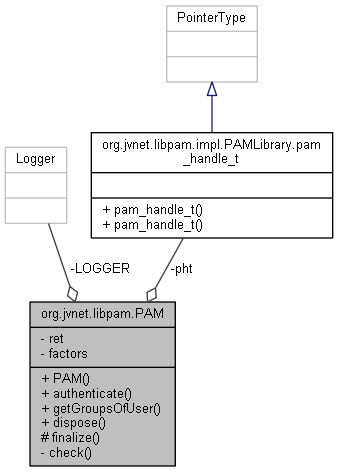
公開メンバ関数 | |
| PAM (String serviceName) throws PAMException | |
| UnixUser | authenticate (String username, String... factors) throws PAMException |
| Set< String > | getGroupsOfUser (String username) throws PAMException |
| void | dispose () |
限定公開メンバ関数 | |
| void | finalize () throws Throwable |
非公開メンバ関数 | |
| void | check (int ret, String msg) throws PAMException |
非公開変数類 | |
| pam_handle_t | pht |
| int | ret |
| String [] | factors |
静的非公開変数類 | |
| static final Logger | LOGGER = Logger.getLogger(PAM.class.getName()) |
詳解
PAM authenticator.
Instances are thread unsafe and non reentrant. An instace cannot be reused to authenticate multiple users.
For an overview of PAM programming, refer to the following resources:
構築子と解体子
◆ PAM()
|
inline |
関数詳解
◆ authenticate()
|
inline |
Authenticate the user with a password.
- 戻り値
- Upon a successful authentication, return information about the user.
- 例外
-
PAMException If the authentication fails.
◆ check()
|
inlineprivate |
◆ dispose()
|
inline |
After a successful authentication, call this method to obtain the effective user name. This can be different from the user name that you passed to the authenticate(String, String) method. Performs an early disposal of the object, instead of letting this GC-ed. Since PAM may hold on to native resources that don't put pressure on Java GC, doing this is a good idea.
This method is called by finalize(), too, so it's not required to call this method explicitly, however.
◆ finalize()
|
inlineprotected |
◆ getGroupsOfUser()
|
inline |
Returns the groups a user belongs to
- 引数
-
username
- 戻り値
- Set of group names
- 例外
-
PAMException
- 非推奨:
- Pointless and ugly convenience method.
メンバ詳解
◆ factors
|
private |
Temporarily stored to pass a value from authenticate(String, String...) to pam_conv.
◆ LOGGER
|
staticprivate |
◆ pht
|
private |
◆ ret
|
private |
このクラス詳解は次のファイルから抽出されました:
- D:/AppData/doxygen/keycloak/federation/src/federation/sssd/src/main/java/org/jvnet/libpam/PAM.java
 1.8.13
1.8.13